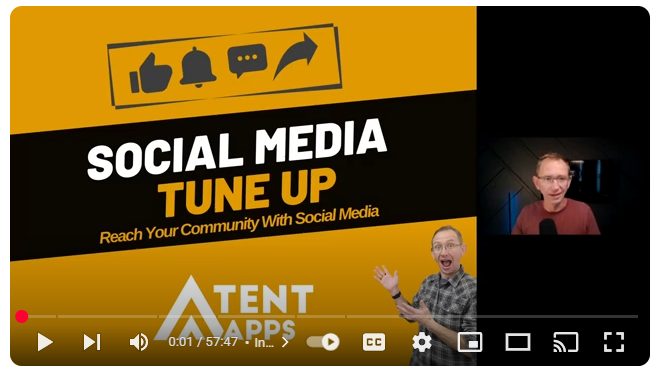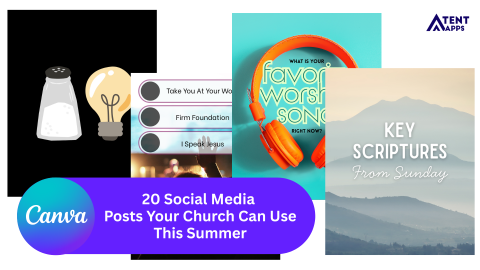Creating Engaging Church Websites: A Guide to Best Practices
Church Website Design is essential for creating a strong online presence for religious organizations. By incorporating features like parallax scrolling, you can transform your mariners church website into a vibrant hub of virtual activity. Selecting the right website builder is crucial for setting the foundation for an inviting online space that reflects the fellowship and community of your congregation. Keep reading to discover actionable tips for creating a church website that truly resonates with your community.
Essential Elements of Engaging Church Website Design
Successful church websites offer more than just aesthetics; they serve as portals for communication and fellowship. Prioritizing user-friendly navigation ensures that visitors can easily find the information they seek, enhancing their digital journey. Including multimedia elements is not only about visual appeal, but it also makes the experience more interactive and engaging. A well-placed call to action empowers visitors to take the next step, whether it’s attending a service or joining a ministry.
Since smartphone and tablet use is on the rise, optimizing for mobile devices is no longer optional; it’s vital for reaching a broader audience. Lastly, integrating social media solidifies the connections between the church community and its members, elevating the church’s online presence. Whether built from scratch or utilizing platforms like Wix, the design of church websites must be strategic, incorporating these pivotal elements to craft an impactful media experience.
Streamlining Navigation for User-Friendliness
Intuitive navigation stands as a cornerstone of any free church website, guiding visitors effortlessly to sermons, service times, and bible study materials. A clearly structured menu, with concise labels, directly influences a visitor’s ability to engage with the site’s content, from ministry events to educational resources.
A visitor’s journey through a church’s digital hallways should reflect the clarity and purpose characteristic of Passion City Church‘s logo. Streamlined, distraction-free pathways allow for an enriching experience, one that encourages exploration while fostering a deeper connection with the church’s mission.
Integrating Multimedia Elements for a Dynamic Experience
A dynamic church website design integrating multimedia draws the viewer into a full sensory experience. By choosing fonts that harmonize with your website‘s atmosphere, you invite a seamless interaction between the user and your church’s digital identity.
Building on the core principles of effective web design, incorporating video sermons, audio recordings of hymns, and visually rich graphics can genuinely engage customers on a more personal level, shaping an immersive web journey that resonates with their spiritual quest.
Featuring a Clear Call to Action for Visitors
The home page of a church website acts as a gateway, beckoning visitors with a simple yet compelling call to action that reflects the teachings of Jesus. A well-crafted message, prominently placed, can guide newcomers to engage deeper with the community, be it through prayer requests or participation in upcoming events.
In the quest to craft a digital space that welcomes and guides, subtle advertising via Squarespace-designed buttons can effectively steer site visitors to take meaningful actions, such as downloading the latest sermon or signing up for a bible study group, fostering a sense of belonging and spiritual growth.
Optimizing for Mobile Devices for Better Accessibility
With the proliferation of handheld devices, an editor‘s role in optimizing church website design for mobile access is paramount. Ensuring that pages load swiftly and seamlessly on smartphones and tablets underscores a commitment to accessibility, making spiritual content and church communications universally available.
Subtle animations, when optimized for mobile viewing, can enrich the user experience without compromising performance. Meanwhile, providing mobile-responsive customer support and content management tools is vital, allowing users to maintain their spiritual connections flawlessly, regardless of the device they use.
Incorporating Social Media Links to Increase Connectivity

A great church website design often serves as a bridge, connecting the sanctuary to the digital space where fellowship continues to thrive. Integrating social media links from platforms like Crossroads Community Church ensures that communication extends beyond Sunday services, fostering ongoing connection and community engagement.
Selecting a church website builder that offers a drag-and-drop interface streamlines the creation process without imposing steep fees. This user-friendly approach empowers church staff to regularly update social media feeds, keeping the congregation informed and involved with the church’s activities.
Trends for Modern Church Website Design in 2024
As the digital face of faith communities, modern church websites prioritize minimalist design, leading visitors through clutter-free layouts and ensuring the price of complexity doesn’t outweigh the value of simplicity. This resonates deeply with congregations like those of the Love Church and numerous Baptist churches, which seek to extend a clear and inviting digital handshake to their community. Hostinger, a popular choice for streamlined content management systems, aids churches in adopting bold typography, a crucial element that accentuates their key messages, making them stand out with conviction.
The strategic use of color not only captivates the eye but also harnesses the power of psychology to radiate warmth and create a welcoming online atmosphere. Additionally, implementing parallax scrolling transforms website storytelling, allowing churches to narrate their vision and mission in an engaging, multi-dimensional scrolling experience. This innovative church website design technique cultivates a more profound immersion into the church’s narrative.
Minimalist Aesthetics for Clutter-Free Layouts

In the spirit of minimalist aesthetics, modern church websites are paring down complex designs to resemble the tranquility of a village retreat, unencumbered by the excess of visual elements. Adopting such a layout steers the focus towards essential icons representative of the church’s identity, like the trinity, fostering an immediate and deeper understanding without the distraction of superfluous graphics or text.
Clutter-free church website design transcends visual impact alone; it streamlines the user experience, simplifying tasks such as donations or payments that could involve a credit card. By embracing simplicity, these websites speak a clear language, removing barriers and creating a pathway for visitors to engage with the church’s digital ministry with ease.
Bold Typography to Highlight Key Messages
The decision to upload bold and sizable font choices on a church web interface can transform mundane text into a striking declaration of the church’s message. When a visitor lands on the bible church’s homepage, it’s the robust typeface in the menu bar that captures attention, directing them with clarity and emphasis to key sections of the site.
Image overlays combined with bold typography can articulate the church’s core values without overwhelming the user. This innovative church website design technique ensures that pivotal information stands out, guiding the viewer’s journey from the moment they arrive, enhancing both aesthetic appeal and functional efficiency.
Using Color Psychology to Evoke Warmth and Welcome
Selecting the right color palette is a subtle yet powerful tool a website manager can use to create an approachable and comforting atmosphere on a church’s online campus. Warm hues in the site’s navigation elements can make information like service hours and mailing list subscriptions more inviting to users.
Soft tones integrated into the website‘s checkout process for donations could promote a sense of trust and serenity, encouraging visitors to engage with the church through payment transactions securely. The strategic use of color aims to welcome site users just as one would be welcomed into a sanctuary, with open arms and a nurturing spirit.
Parallax Scrolling for Immersive Storytelling
Introducing parallax scrolling on a church’s website design grabs attention with its dynamic pace and depth, much like a mobile app captivates its users with fluid motion. This storytelling technique creates a layered visual narrative that draws the visitor deeper into the life of the church community.
San Diego-based congregations who have adopted this web functionality find it a cost-effective upgrade, often with options billed annually, to weave the fabric of their message into an engaging online tapestry. Parallax scrolling makes every paragraph an opportunity to connect with the visitor, encouraging them to linger on the page and absorb the church’s vision.
How to Showcase Your Congregation’s Spirit Online
Creating a digital presence that truly reflects the essence of a church community requires more than mere service listings and contact information. Vibrant online platforms should echo the liveliness of congregation activities, showcasing the authenticity of Christian fellowship. Enticing imagery and detailed descriptions of community events, from baptism ceremonies to volunteer gatherings, invite visitors to picture themselves as part of your spiritual family.
Moreover, sharing testimonials and personal member experiences provides a candid glimpse into the life-changing journeys within your church community. These stories can spark inspiration, compelling newcomers to join your congregation. Additionally, virtual tours of church facilities offer an upfront visual experience, reassuring visitors of a welcoming place for worship and reflection. As followers navigate through these pages, they often encounter intuitive options to show support through donations, reinforcing the link between online experience and church involvement.
Highlighting Community Events and Stories
Adept web developers incorporate features on church websites that allow the spirit of New Testament teachings to come alive through stories of community events. The narrative of each gathering, showcased through the Newspring Church’s online menu, inspires a digital congregation and fosters an inclusive online sanctuary.
To captivate potential members, web developers enable a free trial of interactive features that share the rich tapestry of personal testimonies and community engagements. This innovative church website design technique not only highlights the vibrant church life but also encourages online visitors to envision their roles within the flock, drawing them closer to a spiritual home.
Displaying Testimonials and Member Experiences
Elevation Church‘s approach to showcasing member experiences serves as an exemplary model in harnessing multimedia to tell impactful stories. The strategic selection of images, audio, and video complemented with well-chosen typography enhances the testimonial’s message, maintaining usability while delivering powerful narratives.
Incorporating first-hand accounts into a church’s website adds a layer of personal insight and knowledge for visitors. Thoughtful design decisions, like the placement and styling of text, ensure these stories are accessible and resonate with the community, fostering a sense of connection and shared journey. This innovative church website design technique helps create a more engaging and personalized experience for visitors.
Virtual Tours of Your Church and Facilities
Virtual tours on a good church website design provide an immersive look into the physical sanctuary and community spaces, often becoming a determining factor for newcomers searching for a church home. By embedding this feature, a church can extend an invitation for virtual visitors to experience the warmth and fellowship of their congregation without contravening any terms of service.
This interactive tool surpasses the static nature of images, giving potential members a comprehensive view of the church’s facilities, right from the comfort of their homes. As part of the church’s digital extension, it serves as both a point of sale for church events and a free website feature that invites deeper engagement with the company of believers.
Crafting Content That Resonates With Your Audience
Understanding the unique blend of visitors frequenting a church website and catering to their specific needs is crucial when establishing an online presence. Identifying distinctions between first-time visitors and devoted members allows the development of nuanced content that both informs and inspires. Differentiation is key. For instance, presenting a button for new guests to learn about church values, while directing regular members to a podcast series on more in-depth theological discussions, paves the way for personalized digital experiences.
Crafting content with an engaging tone and texture, akin to the layered depth of parallax design, captivates the user’s attention as the cursor glides across the page. This innovative church website design technique enhances the visitor experience by making information appear limitless yet easily digestible. Diverse offerings, such as an updated blog or news feed, contribute to building a robust church community both online and offline.
Identifying Your Audience: Visitors vs. Regular Members

At Flatirons Community Church, distinguishing between first-time visitors and loyal congregation members is fundamental to providing relevant information. A guest might be searching for general service times or locations accessible via mobile, while a long-standing member could be looking to book a community event or delve into sermon archives on the internet.
Ensuring the church website design accommodates the unique inquiries of various users is essential. Information for newcomers should be prominent and easy to navigate on any mobile device, guiding them through the church’s values and mission, whereas regular attendees might seek deeper engagement through educational resources or online chapters of a study book.
Tailoring Messages for Inspiration and Information
Community is at the heart of a church’s mission, and by reflecting this in their online domain name and content, churches like North Point cultivate a welcoming space for both newcomers and regular attendees. Crafting a message that sparkles with inspiration yet is grounded in information prompts an organic conversation about God, fostering a deeper connection.
Effective church website design curates content that not only informs about events and teachings but also stirs the spirit, prompting visitors to reflect on their relationship with God. This balance of upliftment and education shapes a virtual environment where the essence of the church community is palpable, extending an invitation for engagement well beyond the Sunday service.
Creating an Engaging Blog or News Section
An engaging blog or news section on a church website design serves as a hub where the latest sermons uploaded to Vimeo can be effortlessly downloaded, fostering a digital archive of spiritual nourishment. This resource management tool attends to the congregation’s thirst for knowledge and connection, while subtly promoting the convenience of online giving as a means of support.
Each post enriched with an authentic photograph captures the essence of church life, inviting members to partake in the documented moments of fellowship and service. Such visual storytelling complements the management of content across the platform, encouraging visitors to return for updates and deepening their engagement with the church’s mission.
Best Practices for Enhancing User Experience on Church Websites

Keeping a church website design current and responsive stands as a cornerstone of digital ministry. Regular content updates pull visitors back, offering them a space where inspiration goes hand in hand with the latest events and teachings. Speed is essential too, as fast-loading pages reflect the efficient nature of a modern Christian church. Attention to detail, like ensuring the banner resonates with current themes and the URL stays user-friendly, can transform casual browsers into an engaged congregation. Clear visibility of contact information, alongside straightforward forms, invites interaction and fosters community, laying down the digital welcome mat for both seekers and members alike.
Regularly Updating Content to Keep the Site Fresh
A best practice for church website design is to ensure fresh content by scheduling regular updates, an approach that reflects a lively and active community. The integration of new material, such as updates on church activities and the addition of recent sermons, keeps the website dynamic and engaging.
Churches adopting modern techniques like live streaming services cater to members who use Android and other mobile devices. This not just maintains the church’s relevance but also offers an ongoing invitation for visitors to connect with the church’s message in real time.
Ensuring Fast Load Times and Technical Stability
Efficient church website design ensures that with every scroll, visitors to a church’s web page are met with rapid response times, reflecting the organization‘s commitment to a seamless experience. Employing a builder known for generating technically stable websites prevents downtime, thereby upholding the church’s digital reputation.
Should any technical issues arise, responsive customer service from the website builder can swiftly address concerns, minimizing any interruptions to the user’s experience. It’s the behind-the-scenes stability that allows visitors to navigate the site’s offerings with ease and confidence.
Setting Up Easy-to-Find Contact Information and Forms

Accessible contact details boost a church website‘s service to its congregation, enhancing search engine optimization with relevant keywords for those seeking prayer or community support. By prominently featuring contact methods, a United Methodist Church website design, for example, invites open communication, reflecting its commitment to connect and serve.
A user-centered approach ensures that forms for prayer requests, volunteer sign-ups, or budget contributions are straightforward and easy to submit, whether accessed through a browser or via an app from the App Store. This accessibility helps build trust and fosters a welcoming online environment for both church members and newcomers alike.
Tools and Platforms for Building and Managing Church Websites
Selecting the right tools to construct and maintain an engaging church website is a task that commands attention. Church website design builders such as Wix, Squarespace, and WordPress offer a variety of church website templates that embody minimalism and user-friendly design. These platforms differ in features and functionality, making the comparison of their capabilities essential for any church deciding which software will best serve their needs. Integrating church management software enhances the usefulness of the website, streamlining administrative tasks with the virtual experience.
To optimize site performance and reach, analytics play a pivotal role, allowing churches to refine their online presence continuously and ensure they remain visible and accessible in search engine results. This ongoing process of measurement and improvement is critical for churches to foster a digital space that resonates with their community and fulfills their mission online.
Comparing Website Builders: Wix, Squarespace, and WordPress

Wix is a popular choice for its user-friendly drag-and-drop interface and extensive template library. It’s ideal for those who want a visually appealing website without needing extensive coding knowledge. However, while Wix offers a wide range of features, its flexibility can be somewhat limited compared to other options.
Squarespace is another popular choice known for its sleek and modern templates. It offers a balance of ease of use and customization options. Squarespace is particularly well-suited for those who want a professional-looking website without sacrificing too much control.
WordPress, (Preferred Option by Tent Apps) while requiring more technical knowledge, offers the most flexibility and customization options of the three. Its vast ecosystem of plugins and themes allows you to create virtually any type of website, from simple blogs to complex eCommerce stores. WordPress is also highly scalable, making it a good choice for growing churches or organizations.
Ultimately, the best website builder for you will depend on your specific needs and preferences. Consider factors such as ease of use, customization options, scalability, and budget when making your decision.
Utilizing Church Management Software With Website Integration
Integrating church management software that features photography management capabilities allows staff to effortlessly manage visual content. This kind of tool is invaluable, especially when showcasing activities from a recent church service or narrating stories of the Presbyterian Church community through vivid images.
Effective management of interactive FAQs on a church website design can answer common queries relating to service times, event scheduling, or volunteer opportunities. By embedding this software, a church simplifies information dissemination, making it more accessible and navigable for congregants and visitors alike.
Leveraging Analytics for Continuous Improvement

Analytics are an invaluable aspect of church website design, enabling a church website to evolve beyond its initial launch. By analyzing which pages hold visitors’ attention or prompt them to respond to a call to action, a nonprofit organization can refine their online presence, ensuring that content resonates with their audience on any web browser.
Tracking interactions and measuring the efficacy of different elements on a church website allows for data-driven decisions. This continuous feedback informs website administrators about the most impactful ways to connect with their community and enhances the user journey from first click to ongoing engagement.
Conclusion
Crafting an engaging church website design is pivotal for fostering a virtual space that mirrors a congregation’s vitality and communal spirit. By focusing on user-friendly design, integrating multimedia, and tailoring content to different audiences, churches can create a digital presence that informs and inspires. Regular updates and attention to technical performance ensure a seamless user experience that reflects the church’s commitment to its mission and community. Ultimately, a thoughtfully designed church website can act as a beacon, drawing in new visitors and nurturing the spiritual journey of existing members.





0 Comments